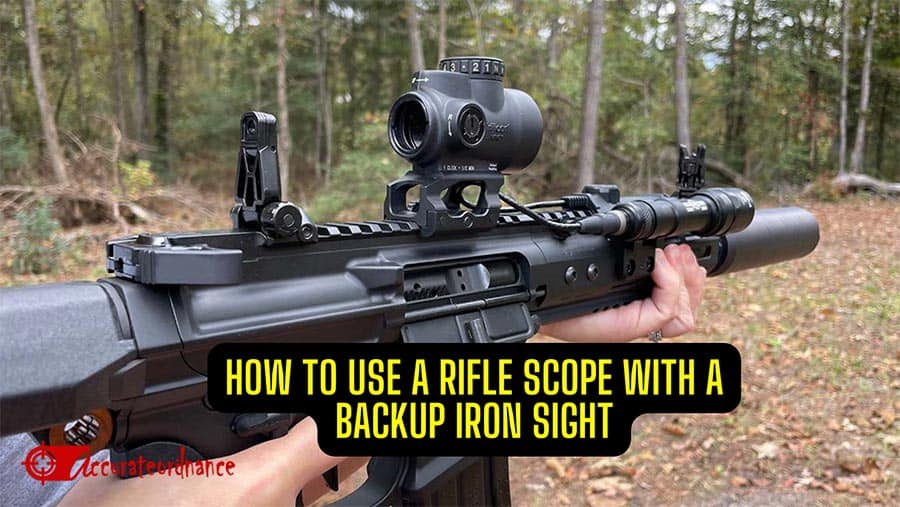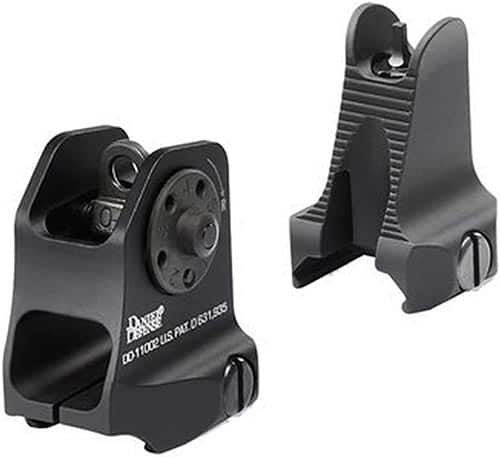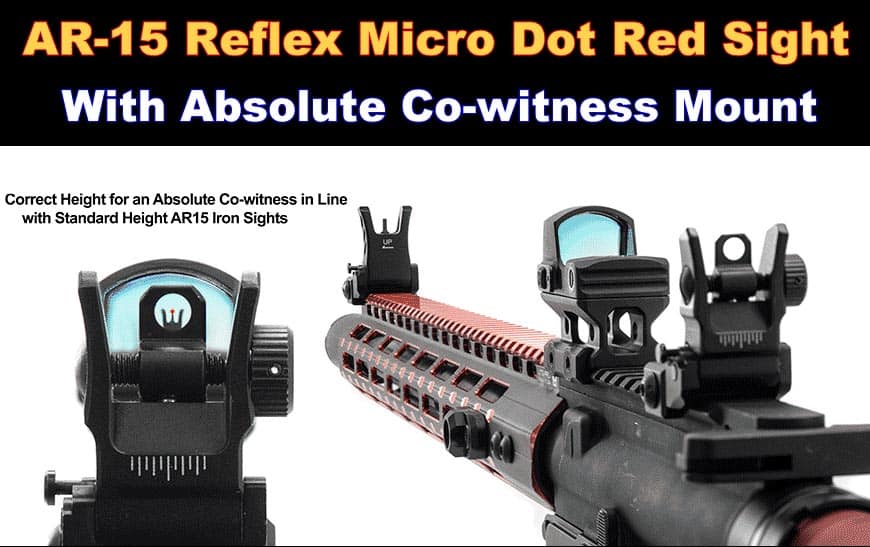Shooting with a riflescope is a popular and effective technique for hitting targets with accuracy and precision. However, relying solely on a scope can be risky, as it can malfunction or become damaged in certain situations. In these scenarios, having a backup iron sight (BUIS) can be crucial for maintaining accuracy and hitting targets effectively. This article is a comprehensive guide on how to use a rifle scope with a backup iron sight. You’ll learn about all a shooter needs to enhance their shooting experience and prepare for potential equipment failures.

Whether you are a hunter, sport shooter, or tactical professional, understanding how to use a backup iron sight with a rifle scope is a valuable skill that can improve your overall shooting experience. By following the guidelines provided in this article, shooters can maximize their accuracy and increase their chances of success, even in situations where their primary sighting system may fail.
- Riflescope and Iron sight
- Importance of using a backup iron sight with a rifle scope
- Which Type of Scope Can Be Used as a Co witness Sight
- Compatibility of rifle scope and backup iron sight
- Zeroing in the riflescope and iron sight
- Importance of Learning to Transition from Scope to Iron sight
- Steps on transitioning from scope to iron sight
- Advantage of Using a Backup Iron Sight
Riflescope and Iron sight
A rifle scope is a sighting device that is attached to a rifle to improve accuracy and precision while shooting. It consists of a tube with lenses that magnify the image of the target and crosshairs or reticles that aid in aiming. Riflescopes come in various types, sizes, and magnification ranges and are often used by hunters, sports shooters, and military personnel.
A backup iron sight (BUIS), on the other hand, is a mechanical sight that is mounted on a rifle as a secondary sighting system. It is designed to provide a shooter with a reliable and accurate backup aiming option if the primary sighting system fails or becomes damaged. BUIS typically consists of a front sight post and a rear sight aperture, and it is commonly used by military and law enforcement personnel and some sport shooters and hunters.

While a rifle scope offers many advantages, such as increased accuracy at long distances, it is not infallible and can suffer from mechanical failure, damage, or obstruction. A backup iron sight can be an invaluable tool in these situations, as it allows the shooter to continue aiming accurately and hitting their target. By understanding how to use a rifle scope and backup iron sight together effectively, shooters can enhance their overall shooting experience and improve their chances of success.
Importance of using a backup iron sight with a rifle scope
There are several reasons why using a backup iron sight with a riflescope is important.
Secondary Aiming
Firstly, it provides a secondary aiming option in case the primary sighting system fails or becomes damaged. This can happen in various situations, such as extreme weather conditions, accidental damage, or mechanical malfunction. Having a backup iron sight can ensure that the shooter can continue to aim accurately and hit their target, even when their primary sighting system is compromised.
Enhanced Situational Awareness
Secondly, a backup iron sight can enhance situational awareness. Unlike a scope, which can limit the shooter’s field of vision, a backup iron sight allows the shooter to maintain a wider field of view, enabling them to better assess the surrounding environment and identify potential threats or obstacles. This can be particularly important in tactical situations where split-second decisions can be crucial.
Better Shooting Adaptability
Lastly, a backup iron sight can provide a valuable training opportunity. By practicing transitioning from a riflescope to a backup iron sight, shooters can improve their shooting skills and become more versatile and adaptable in various situations. This can also help shooters to develop muscle memory and enhance their overall shooting proficiency.
Which Type of Scope Can Be Used as a Co witness Sight
When cowitnessing a riflescope with an iron sight, choosing a scope that is compatible with the iron sight is important and allows for a proper cowitness. The most common type of scope used for cowitnessing with iron sights is a red dot sight.

Red dot sights are meant to be used with both eyes open, and they allow shooters to maintain situational awareness. They also provide a quick and easy aiming reference, which can be especially useful in close-quarters combat situations. Red dot sights are typically mounted on the rifle in a way that allows them to be used as a co witness sight with iron sights, meaning that both the red dot sight and iron sight can be seen through the same plane of vision.
The two popular types of red dots include reflex sight and holographic sight. A Reflex sight may be open or tube style, while a holographic sight is usually tube style.
It is important to note that not all red dot sights are compatible with iron sights, and the mounting system used may also affect the ability to co-witness. Therefore, it is important to research and choose a red dot sight that is specifically designed for cowitnessing with backup iron sights, and ensure that it is properly mounted and zeroed in before use.
Compatibility of rifle scope and backup iron sight
When mounting a riflescope (most likely a red dot sight) with a backup iron sight, it is important to ensure they are compatible. The compatibility of a riflescope and BUIS refers to their ability to work together effectively without interfering with each other’s operations.
Compatibility can be affected by several factors, including the type of scope, the mounting system used, and the height and position of each sighting system on the rifle. Let us go into more detail on factors to consider when determining the compatibility of a riflescope and BUIS:
Type of Scope and BUIS
The type of scope can affect compatibility with an iron sight. For example, a scope with a large objective lens may require a higher mounting position, which will not match the view of a low-profile BUIS. Similarly, a scope with a longer eye relief may require the BUIS to be mounted further forward on the rifle to avoid interference. It is important to consider the dimensions and specifications of both the scope and BUIS before purchasing them to ensure that they will work together effectively.
Mounting System
The mounting system used for the scope can also affect its compatibility with the iron sight. Some riflescopes may require specific mounting systems, such as Picatinny or Weaver rails, to be properly mounted. You must ensure that the mounting system used matches and aligns with the iron sight. A misaligned mount may lead to inaccurate shots.
Height and Position
The height and position of the riflescope and iron sight on the rifle can also affect their compatibility. Both the scope and BUIS should be mounted at the same height and positioned relative to each other so that they do not interfere with each other’s operation. If the BUIS is mounted too high or too low, it may obstruct the view of the rifle scope. Similarly, if the rifle scope is mounted too far forward or back, it may interfere with the operation of the BUIS.
It is important to consider these factors when choosing a scope and BUIS to ensure their compatibility and effective use. It is recommended to consult with a professional gunsmith or refer to the manufacturer’s instructions for the scope to ensure proper installation and zeroing in.
Zeroing in the riflescope and iron sight
Zeroing a scope and an iron sight is all about adjusting both sighting systems to align with the bullet’s point of impact. This is essential for accurate shooting and ensures that both the scope and iron sight can be used interchangeably depending on the situation. Here are the steps to zero in these two sighting systems:
Mount the Scope and BUIS
Mount the scope on the rifle according to the manufacturer’s instructions. Ensure that both sighting systems are properly aligned and mounted at the correct height and relative position.
Choose a Target
Choose a target at a reasonable distance (100 yards is commonly used to zero scopes) and set up a stable shooting position. Ensure that the target is clearly visible through the riflescope.
Adjust the BUIS
With the rifle scope turned off or covered, use the BUIS to take a shot at the target. Observe where the bullet hits and make adjustment to the BUIS accordingly to align with the point of impact.
Adjust the Rifle Scope
With the BUIS adjusted, use the scope to take a shot at the same target. Observe where the bullet hits and do some sight adjustments for the scope to align with the point of impact.
Repeat and Fine-Tune
Repeat steps 3 and 4 until both the rifle scope and BUIS are zeroed in and aligned with the point of impact. Fine-tune the adjustments as necessary to ensure maximum accuracy.
It is important to note that zeroing a scope and an iron sight may require several shots and sight adjustments and should be done in a safe and controlled environment. It is recommended to consult with a professional gunsmith or shooting instructor for guidance and assistance in zeroing an iron sight. Once zeroed in, both sighting systems can be used interchangeably depending on the situation, providing greater versatility and accuracy for the shooter.
Importance of Learning to Transition from Scope to Iron sight
Transitioning from riflescopes to iron sights is an important skill for any shooter. While rifle scopes offer magnification and precision at longer ranges, they can also have limitations, such as a narrow field of view, eye relief issues, and dependency on battery power. Iron sights, on the other hand, provide a wider field of view and can be used in various shooting scenarios. Here are some reasons why transitioning from a rifle scope to iron sights is important:
Versatility
A shooter who is able to transition from riflescopes to iron sights can effectively engage targets at various ranges and in different shooting scenarios. This versatility can be important in hunting, military and law enforcement operations, and competitive shooting.
Reliability
Iron sights do not rely on batteries or electronics, making them more reliable than rifle scopes. In a situation where the scope malfunctions or fails, a shooter who is proficient with iron sights can quickly transition and continue to engage targets.
Rapid Target Acquisition
Iron sights allow for quicker target acquisition, especially at close ranges where a riflescope may be less effective. The shooter can simply raise the rifle and align the iron sights with the target, without the need for magnification or adjustments.
Steps on transitioning from scope to iron sight
If your scope suddenly breaks down as a result of battery or mechanical failure, you may need to quickly switch to using your backup iron sight. Transitioning between these sights requires a few key steps to ensure accuracy and proficiency.
Identify the Target
Identify the target and determine the appropriate range for the shot. Take into account the size of the target, the terrain, and any obstacles or barriers that may affect the shot. If you have practiced enough with your iron sight, you should be able to estimate the range through observation and any other factors that need to be considered.
Flip Up the Iron Sight
Flip up the iron sights on the rifle. Make sure they are properly aligned and in the correct position relative to the shooter’s eye.
Lower the Head
Lower your head and position your cheek on the stock of the rifle. This will allow you to properly align the iron sights with the target.
Align the Iron Sights
Look through the rear iron sight and align it with the front iron sight. The front sight should be in the center of the rear sight. Align the iron sights with the target.
Take the Shot
Take the shot when the iron sights are properly aligned with the target. Be sure to maintain proper trigger control and follow-through.
Repeat and Practice
Repeat this process to become proficient at transitioning from scopes to iron sights. Practice this skill regularly to improve muscle memory and reaction times.
Transitioning from a riflescope to backup iron sights takes practice and patience to become proficient. However, by following these steps and practicing regularly, a shooter can effectively engage targets in a wide range of shooting scenarios.
Advantage of Using a Backup Iron Sight
Aside from the benefits of using an iron sight discussed above, here is an additional one.
Close-Range Shooting
BUIS are designed for close-range shooting and provide an effective alternative to using a scope at short distances. This is because iron sights do not require any magnification, which can slow down target acquisition at close ranges.
Disadvantages of Using a Backup Iron Sight
While using a backup sight has several advantages, there are also some potential disadvantages to consider.
Limited Range
Iron sights are typically less effective than riflescopes at longer ranges. This is because they do not provide any magnification, making it more difficult to see distant targets clearly. As a result, using a BUIS may not be ideal for shooters who frequently engage in long range shooting.
Sight Picture
Transitioning from a riflescope to iron sights requires the shooter to adjust their sight picture, which can take time and practice to master. This can be challenging for novice shooters or those who have not trained extensively with iron sights.
To get the most out of a riflescope and backup iron sight, shooters should choose compatible optics and iron sights, zero them in accurately, and practice transitioning between the two sighting systems to ensure a smooth and rapid transition. Shooters should also consider their specific needs and preferences when selecting a scope and backup iron sight, taking into account factors such as range, shooting scenarios, and budget.
Ultimately, using a backup sight in conjunction with a riflescope can provide shooters with added versatility, confidence, and preparedness in a wide range of shooting scenarios. By carefully selecting and mastering their sighting systems, shooters can enhance their accuracy, effectiveness, and overall shooting experience.

Mike Hardesty is a published freelance gun writer. He also possesses specialized expertise in rifle scopes With dozens of articles and reviews published in Pew Pew Tactical, Snipercountry.com, and TTAG (The Truth About Guns), Mike is considered a firearms expert. His special area of expertise is handguns.
Mike is a long-time shooter. He has been punching paper targets, taking deer and other game and shooting at competitions since about 1975. Other related pursuits include reloading and bullet casting. He currently reloads for over 10 calibers, both handgun and rifle. His reloads, particularly for 9mm, were in great demand during the height of the ammo shortage among family and friends. He donated hundreds of rounds to informal shooting sessions. He was quoted as saying “I do not sell my reloads but I sure will help my guys shoot ’em for free!”. He has a few cherished firearms that he has inherited or otherwise procured — those are his favorites.
He earned B.S. and M.S. degrees from Indiana State University in 1974-1975.
He’s a firearm experts and is the founder of mhardesty.com.
